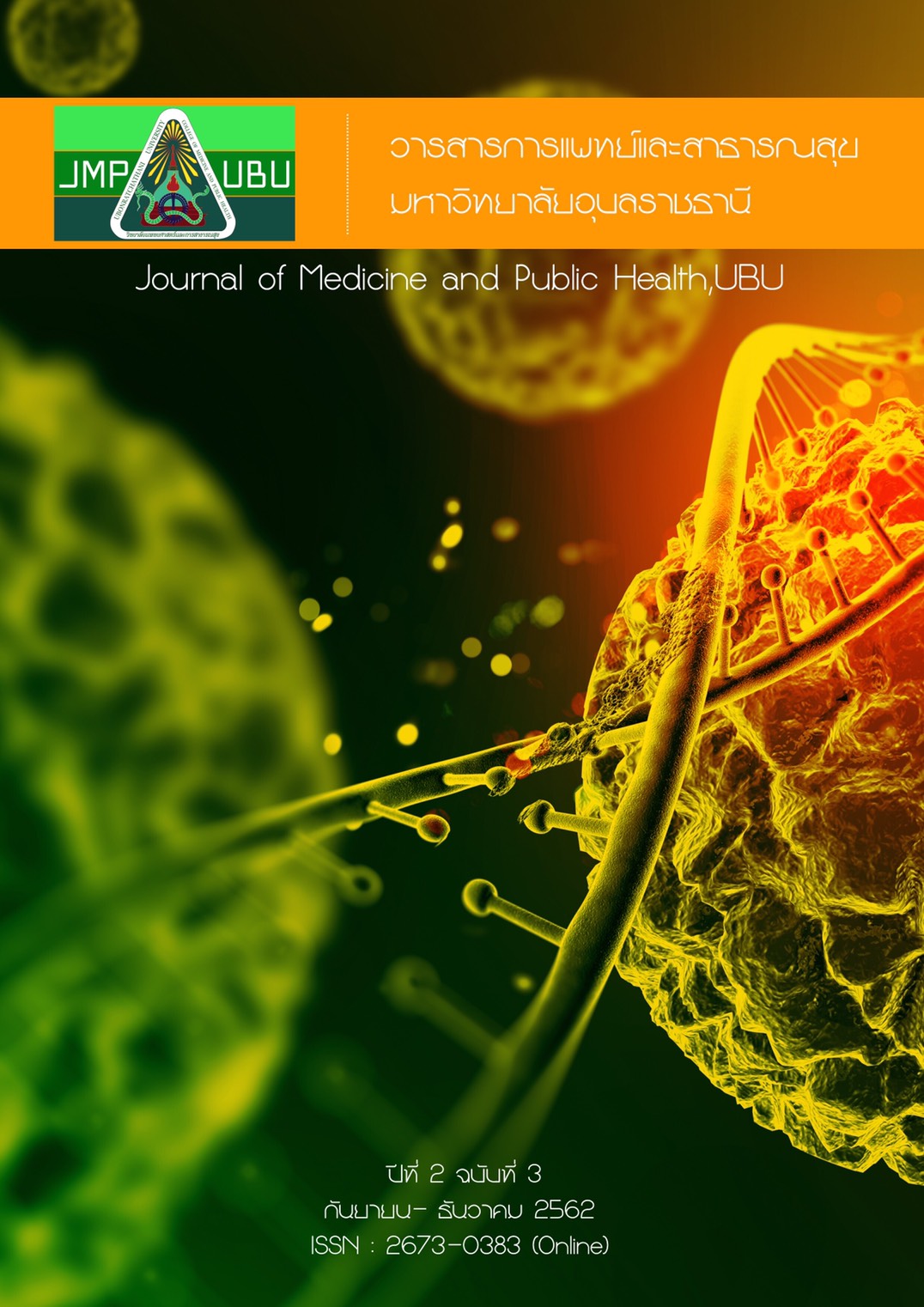ผลทางโลหิตวิทยาของฟลูออไรด์และการเกิดฟันตกกระในเด็กนักเรียนอำเภออมก๋อย จังหวัดเชียงใหม่ : การอธิบายความสัมพันธ์เชิงพื้นที่ระหว่างการจัดการน้ำในชุมชนกับการเกิดฟันตกกระและกลไกของฟลูออไรด์ต่อความผิดปกติทางโลหิตวิทยา
คำสำคัญ:
ผลทางโลหิตวิทยา, โลหิตจาง, ความสมบูรณ์ของเม็ดเลือด, ฟลูออไรด์, ฟันตกกระบทคัดย่อ
การวิจัยนี้มีวัตถุประสงค์เพื่อ 1) เปรียบเทียบความชุกของฟันตกกระระหว่างกลุ่มตัวอย่างที่อยู่ในพื้นที่ฟลูออไรด์สูงกับที่อยู่ในพื้นที่ฟลูออไรด์ต่ำ 2) ประเมินความแตกต่างของผลการตรวจวัดความสมบูรณ์ของเม็ดเลือดระหว่างกลุ่มตัวอย่างที่อยู่ในพื้นที่ฟลูออไรด์สูงกับที่อยู่ในพื้นที่ฟลูออไรด์ต่ำ และอธิบายผลของฟลูออไรด์ต่อความผิดปกติของเลือด 3) หาความสัมพันธ์เชิงพื้นที่ระหว่างการจัดการน้ำในชุมชนกับการเกิดฟันตกกระ ผลการศึกษาพบว่าฟลูออไรด์ในเลือดมีความสัมพันธ์กับการเกิดฟันตกกระอย่างมีนัยสำคัญทางสถิติ โดยพบความชุกของฟันตกกระเพิ่มขึ้นจากร้อยละ 29.9 ในพื้นที่ฟลูออไรด์ต่ำ เป็นร้อยละ 44.5 ในพื้นที่ฟลูออไรด์สูง และยังพบว่าฟลูออไรด์ทำให้เกิดผลทางโลหิตวิทยาที่แตกต่างกันขึ้นกับปริมาณที่รับเข้าสู่ร่างกาย โดยกลุ่มตัวอย่างในพื้นที่ฟลูออไรด์สูงมีค่า White Blood Cell (WBC), Hematocrit (Hct), Mean cell volume (MCV), Mean cell hemoglobin concentration (MCHC) และค่า Platelets (Plt) แตกต่างกันอย่างมีนัยสำคัญทางสถิติกับในพื้นที่ฟลูออไรด์ต่ำ ผลที่ได้นี้คล้ายกันในกลุ่มตัวอย่างที่ฟลูออไรด์ในเลือด > 0.043mg/L กับกลุ่มที่ฟลูออไรด์ในเลือด ≤ 0.043mg/L ที่พบความแตกต่างกันอย่างมีนัยสำคัญทางสถิติของค่า Hct, MCV, MCHC และ Plt ยกเว้นค่า WBC เท่านั้นที่ไม่แตกต่าง ขณะที่เมื่อเปรียบเทียบค่า CBC parameters ระหว่างกลุ่มตัวอย่างที่ฟลูออไรด์ในน้ำบริโภค > 0.7mg/L กับกลุ่มตัวอย่างที่ฟลูออไรด์ในน้ำบริโภค ≤ 0.7mg/L พบค่า MCV, MCHC และค่า Plt แตกต่างอย่างมีนัยสำคัญทางสถิติ การวิเคราะห์ตัวแบบเชิงเส้นแบบนัยทั่วไปพบว่าหากควบคุมปริมาณฟลูออไรด์ในน้ำดื่มไม่ให้เกินเกณฑ์มาตรฐานและหาแหล่งน้ำบริโภคที่มีความปลอดภัยให้ประชาชนได้ จะลดความเสี่ยงต่อฟันตกกระลงได้ 2.72 เท่า และ 3.94 เท่า ตามลำดับ มาตรการสำคัญในการแก้ไขปัญหาฟลูออไรด์ จะต้องส่งเสริมพฤติกรรมของประชาชนที่ลดความเสี่ยงในการรับฟลูออไรด์ลงโดยมีทางเลือกเกี่ยวกับแหล่งน้ำ และการใช้น้ำเพื่อการบริโภคอย่างถูกต้อง รวมทั้งต้องมีการเฝ้าระวังความผิดปกติหรือกลุ่มอาการที่เกี่ยวข้องกับการได้รับฟลูออไรด์ทั้งความผิดปกติของเลือดและฟันตกกระ
Downloads
เอกสารอ้างอิง
2. Petersen PE. Global policy for improvement of oral health in the 21st century--implications to oral health research of World Health Assembly 2007, World Health Organization. Community Dent Oral Epidemiol. 2009; 37(1):1-8.
3. สถาบันวิจัยระบบสาธารณสุข. ฟลูออไรด์ ภัยเงียบในน้ำดื่ม น้ำใช้ [online]. แหล่งข้อมูล: https://www. hsri.or.th/people/media/care/detail/5932 [เข้าถึงเมื่อ 22 ตุลาคม 2562].
4. Ekstrand J, Ziegler EE, Nelson SE, Fomon SJ. Absorption and retention of dietary and supplemental fluoride by infants. Adv Dent Res 1994; 8(2):175-180.
5. McDonagh MS, Whiting PF, Wilson PM, Sutton AJ, Chestnutt I, Cooper J, et al Systematic review of water fluoridation. BMJ 2000; 321(7265):855-59.
6. Liu M, Qian C. Effect of endemic fluorosis on children's intelligence development: a Meta-analysis. Zhongguo Dang Dai Er Ke Za Zhi 2008; 10(6):723-25.
7. Pornprasert S, Wanachantararak P, Kantawong F, Chamnanprai S, Kongpan C, Pienthai N., et al. Excessive fluoride consumption increases haematological alteration in subjects with iron deficiency, thalassaemia, and glucose-6-phosphate dehydrogenase (G-6-PD) deficiency. Environ Geochem Health 2017; 39(4):751-58.
8. Somnath S Kshirsagar, Archana S Injal, Rao KR. Effect of Sodium fluoride on Hematological parameters in freshwater edible fish, Rita rita. European J. Biotechnol. Biosci. 2016; 4(6):23-26.
9. DenBesten P, Li W. Chronic Fluoride Toxicity: Dental Fluorosis. Monogr Oral Sci. 2011; 22: 81–96.
10. Xiang Qy, Liang YX, Chen BH, Wang CS, Zhen SQ, Chen XD, et al. Serum fluoride and dental fluorosis in two villages in China. Fluoride. 2004; 37(1):28-37.
11. Zulfiqar S, Rehman S, Ajaz H, Elahi S, Zaman W, Batool N, Yasmeen F. Correlation of Water Fluoride with Body Fluids, Dental Fluorosis and FT4, FT3 –TSH Disruption among Children in an Endemic Fluorosis area in Pakistan. Open Chemistry. 2019; 17(1): 465-474.
12. Adler P, & World Health Organization. Fluorides and human health [online]. Available from: https://apps.who.int/iris/ handle/10665/ 41784?show=full [cited 24 May 2016].
13. Abbas M, Siddiqi MH, Khan K, Zahra K, Naqvi AU. Haematological evaluation of sodium fluoride toxicity in oryctolagus cunniculus. Toxicol Rep. 2017; 19(4):450-454.
14. Kokot Z, Drzewiecki D. Fluoride levels in hair of exposed and unexposed populations in Poland. Fluoride. 2000; 33(4):196-204.
15. Barbier O, Arreola-Mendoza L, Del Razo LM. Molecular mechanisms of fluoride toxicity. Chem Biol Interact. 2010; 188(2):319-33.
16. Shuhua X, Ziyou L, Ling Y, Fei W, Sun G. A role of fluoride on free radical generation and oxidative stress in BV-2 microglia cells. Mediators Inflamm. 2012; 2012:102954.
17. Varol E, Icli A, Aksoy F, Bas HA, Sutcu R, Ersoy IH, et al. Evaluation of total oxidative status and total antioxidant capacity in patients with endemic fluorosis. Toxicol Ind Health. 2013; 29(2): 175-80.
18. Agalakova NI, Gusev GP. Fluoride-induced death of rat erythrocytes in vitro. Toxicol In Vitro. 2011; 25(8):1609-18.
19. World Health Organization. Guidelines for drinking-water quality. Vol. 2. Geneva, 1999.
20. ฉัตร์ภัทร์ คงปั้น. การทบทวนวรรณกรรมเกี่ยวกับปริมาณฟลูออไรด์ในน้ำนมของมารดา. เอกสารประกอบการประชุมวิชาการส่งเสริมสุขภาพและอนามัยสิ่งแวดล้อมแห่งชาติ ครั้งที่ 4 พ.ศ. 2554 เรื่องสุขภาพดี ชีวีสดใส อนาคตก้าวไกล; 17-19 สิงหาคม 2554 ณ อิมแพคเมืองทองธานี จังหวัดนนทบุรี. 1-4.
ดาวน์โหลด
เผยแพร่แล้ว
รูปแบบการอ้างอิง
ฉบับ
ประเภทบทความ
สัญญาอนุญาต
เนื้อหาและข้อมูลในบทความที่ลงตีพิมพ์ในวารสารการแพทย์และสาธารณสุข มหาวิทยาลัยอุบลราชธานี ถือเป็นข้อคิดเห็นและความรับผิดชอบของผู้เขียนบทความโดยตรง ซึ่งกองบรรณาธิการวารสารไม่จำเป็นต้องเห็นด้วย หรือร่วมรับผิดชอบใด ๆ
บทความ ข้อมูล เนื้อหา รูปภาพ ฯลฯ ที่ได้รับการตีพิมพ์ในวารสารการแพทย์และสาธารณสุข มหาวิทยาลัยอุบลราชธานี ถือเป็นลิขสิทธิ์ของวารสารการแพทย์และสาธารณสุข มหาวิทยาลัยอุบลราชธานี กองบรรณาธิการไม่สงวนสิทธิ์ในการคัดลอกเพื่อการพัฒนางานด้านวิชาการ แต่ต้องได้รับการอ้างอิงที่ถูกต้องเหมาะสม






